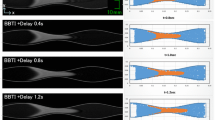Summary
Magnetic Resonance Imaging (MRI) was used to obtain new information about fluid flow patterns in hollow fiber reactors. Significant changes in inlet flow distribution were observed as a function of Reynolds number. Images taken at the tube bundle entrance and exit showed that maldistribution of flow persists throughout the module. Furthermore, the results suggest that individual fibers act in a mixed degree as feeders or collectors depending upon radial position. These effects must be considered when modelling or designing hollow fiber reactors.
Similar content being viewed by others
References
Dixon, R.L. and Ekstrand, K.E. (1982).Med. Phys. 9(6), 807–818
Park, J.K. and Chang, H.N. (1986).AIChE J. 32(12), 1937–1947
Saloner, D. and Moran, P.R. (1987).Med. Phys. 14(2), 167–171
Singer, J.R. (1978).J. Phys. E. 11, 281–291
Author information
Authors and Affiliations
Rights and permissions
About this article
Cite this article
Pangrle, B.J., Walsh, E.G., Moore, S. et al. Investigation of fluid flow patterns in a hollow fiber module using magnetic resonance velocity imaging. Biotechnol Tech 3, 67–72 (1989). https://doi.org/10.1007/BF01876224
Issue Date:
DOI: https://doi.org/10.1007/BF01876224




